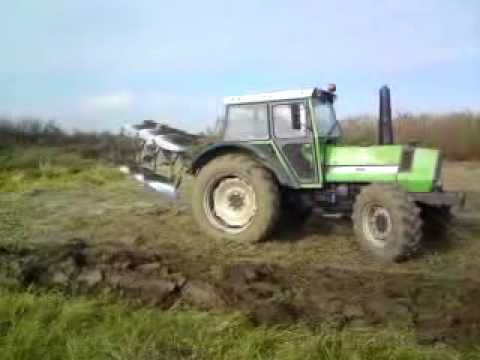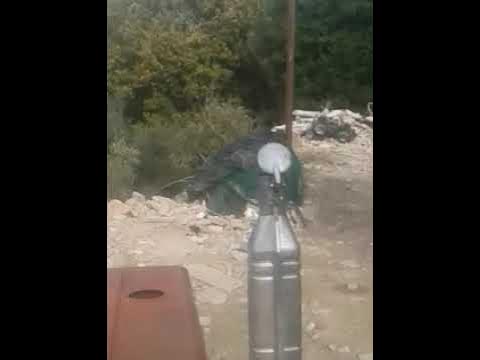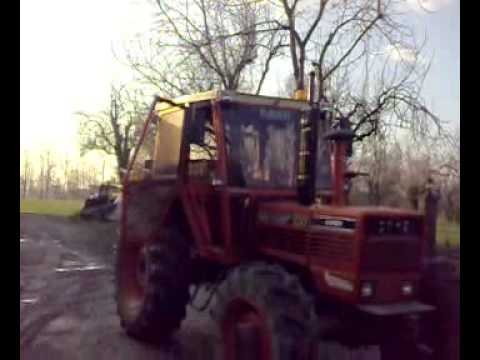- Joined
- Jul 5, 2003
- Messages
- 3,968
- Location
- Laag Zuthem
- First name
- Renze
Machinery:
1976 5718
1978 5718 35kmh: Work in progress
1967 3011
I am a fan of inline 5 cylinder engines, because they run so good in my Volvo (Volkswagen 2.5 TDI) and many other automotive applications like the legendary Audi Quattro, or the Mercedes diesels. I have expressed my preference for an inline five, over the 170hp four cylinder models sold by Valtra and MF in the past here on this forum... But now i just found a harmonic balance study of what the harmonic vibrations of a five cylinder setup would mean with the geometrical layout of the Zetor engine.
This is in Czech, and aside of that, its a bit complicated when youre not familiar with the matter so Google translate makes a mess of it so i havent read it all, but its interesting to see that they have already explored the feasibility of a 5 cylinder engine in the UR3 engine family...
The Zetor engine is a bit small compared to the 4.9 liter AgcoPower engine in the big Valtra and MF four cylinder models, and Deutz has just introduced a TCD 5.0 four cylinder to complement their TCD 4.1 which is a bit small compared to the competition that counts anywhere between 4.4 to 4.9 liter.
Downsizing is really the trend, but Zetor cant build a new engine for every liter of displacement like Deutz does. Also, in the current era of emission legislation it doesnt make sense to offer both a 4 and a six cylinder variant within the same model range, because both would need an individual homologation. So, an inline 5 engine based on the existing Zetor design would make sense, with the current power level it would be capable of 170hp, or 183hp if you compare it to the 147hp Forterra 150HD...
...Which means both Forterra HD and Crystal models could be united into a mid range with an inline 5 engine ranging from 130 to 170hp, replacing both 4 and 6 cylinder models, with only one homologation... Then later the Maxterra (or perhaps Super, like the original heavy Zetor of 1954) could pick up at 160-240hp with inline sixes...
This study is off course 7 years old, and there is no indication that this idea is still hot at Zetor... But who knows...

....And here is a more recent study (of 2016) to explore the possibilities of increasing the UR3 engine displacement..
An increase of the bore and stroke from 105/120 to 115/136 is the biggest size explored, however it would need extensive redesign because the block walls between the cylinders would be too thick to accomodate the big bore liners, and the crankshaft throw would be so big that it hits the counterbalance shafts. (modifying that, would mean beginning from scratch)
Also, stuffing cylinders too close together (like the Ford 112x112mm rebore of the original Major engine, beginning with the Ford 4000 3 cylinder modification although the problem was most evident in the early 1980s four cylinder engines: The three and six cylinder engines had a different balance that didnt propagate this problem as much) will remove too much stiffness from the block, which resulted in the "porous block problem" which was simply a matter of block cavitation because the natural frequency of the block was changed because of this bore increase. The solution was later, an anticavitation coolant addition, and external reinforcement ribs on the 4 cylinder block, to regain the required stiffness. Also the Perkins a6.354 turbocharged, cracked its heads because there wasnt enough heat sink mass.. This very engine is the reason MF changed to Valmet engines for their 150hp and bigger models... The Perkins A6.354 by the way, was as long as a 8011 engine and therefor offered by Motokov UK as a six cylinder alternative to the 10011, fitting under the Zetor 4 cylinder hood... The gap between cab and hood only increased an inch or so with this retrofit..
The most feasible modification to the existing engine is the variant with 110mm bore (alike the Crystal, though the Crystal had 150mm bore spacing and the Forterra has 136mm) and the 126mm stroke, which would increas the four cylinder displacement from 4.156 liter to 4.790 liter (allmost the UR4 engine, which had 110/128mm bore/stroke)
Anyways, i very much prefer the 5 cylinder 5.2 liter variant. No risk of boring away the stiffness of a block and getting Ford cavitation problems, and only one emission homologation for the entire midrange 130-170hp series...
This is in Czech, and aside of that, its a bit complicated when youre not familiar with the matter so Google translate makes a mess of it so i havent read it all, but its interesting to see that they have already explored the feasibility of a 5 cylinder engine in the UR3 engine family...
The Zetor engine is a bit small compared to the 4.9 liter AgcoPower engine in the big Valtra and MF four cylinder models, and Deutz has just introduced a TCD 5.0 four cylinder to complement their TCD 4.1 which is a bit small compared to the competition that counts anywhere between 4.4 to 4.9 liter.
Downsizing is really the trend, but Zetor cant build a new engine for every liter of displacement like Deutz does. Also, in the current era of emission legislation it doesnt make sense to offer both a 4 and a six cylinder variant within the same model range, because both would need an individual homologation. So, an inline 5 engine based on the existing Zetor design would make sense, with the current power level it would be capable of 170hp, or 183hp if you compare it to the 147hp Forterra 150HD...
...Which means both Forterra HD and Crystal models could be united into a mid range with an inline 5 engine ranging from 130 to 170hp, replacing both 4 and 6 cylinder models, with only one homologation... Then later the Maxterra (or perhaps Super, like the original heavy Zetor of 1954) could pick up at 160-240hp with inline sixes...
This study is off course 7 years old, and there is no indication that this idea is still hot at Zetor... But who knows...
....And here is a more recent study (of 2016) to explore the possibilities of increasing the UR3 engine displacement..
An increase of the bore and stroke from 105/120 to 115/136 is the biggest size explored, however it would need extensive redesign because the block walls between the cylinders would be too thick to accomodate the big bore liners, and the crankshaft throw would be so big that it hits the counterbalance shafts. (modifying that, would mean beginning from scratch)
Also, stuffing cylinders too close together (like the Ford 112x112mm rebore of the original Major engine, beginning with the Ford 4000 3 cylinder modification although the problem was most evident in the early 1980s four cylinder engines: The three and six cylinder engines had a different balance that didnt propagate this problem as much) will remove too much stiffness from the block, which resulted in the "porous block problem" which was simply a matter of block cavitation because the natural frequency of the block was changed because of this bore increase. The solution was later, an anticavitation coolant addition, and external reinforcement ribs on the 4 cylinder block, to regain the required stiffness. Also the Perkins a6.354 turbocharged, cracked its heads because there wasnt enough heat sink mass.. This very engine is the reason MF changed to Valmet engines for their 150hp and bigger models... The Perkins A6.354 by the way, was as long as a 8011 engine and therefor offered by Motokov UK as a six cylinder alternative to the 10011, fitting under the Zetor 4 cylinder hood... The gap between cab and hood only increased an inch or so with this retrofit..
The most feasible modification to the existing engine is the variant with 110mm bore (alike the Crystal, though the Crystal had 150mm bore spacing and the Forterra has 136mm) and the 126mm stroke, which would increas the four cylinder displacement from 4.156 liter to 4.790 liter (allmost the UR4 engine, which had 110/128mm bore/stroke)
Anyways, i very much prefer the 5 cylinder 5.2 liter variant. No risk of boring away the stiffness of a block and getting Ford cavitation problems, and only one emission homologation for the entire midrange 130-170hp series...




